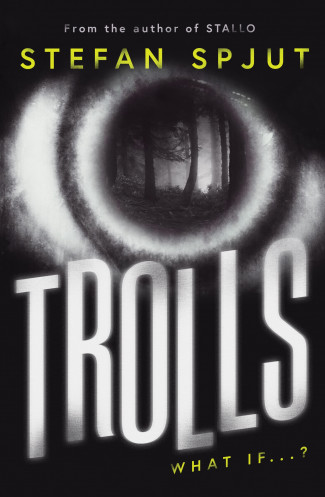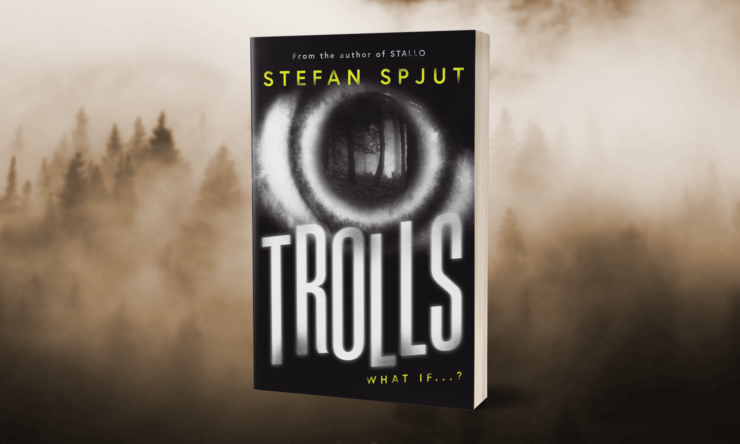The idea of unearthly or folkloric creatures living alongside humanity is one that plenty of writers have embraced over the years. Using that as a starting point, countless authors have told stories that range from the mythic to the comic, from the horror-laden to the sublime. Trolls, the new novel from Stefan Spjut, also makes use of this conceit, but the author takes it to a very different place than most of his peers—somewhere decidedly bleak and disquieting. It doesn’t always click, but when it does it’s bone-chillingly effective.
Trolls shares a setting and some characters with The Shapeshifters—known as Stallo outside of the United States—which was published in translation here in 2015. Spjut’s first novel set in this world introduced the character of Susso Myren, a woman with a family connection to the world of trolls—here, essentially, shapeshifters, some of whom have uncanny psychic abilities. While that novel concerned itself with the search for a missing child—and an unsolved case that it echoed from decades earlier—this novel is more immediate. At times, it also feels like Spjut returning to the territory of a fairly self-contained novel and giving himself space to explore this fictional world further; while this novel also reaches a satisfying conclusion, it wouldn’t be shocking to see its author return to this setting again.
Trolls begins with two men capturing a wolf of massive size—establishing from the outset that something is deeply wrong here. As they continue driving through a lonely landscape, each of them begins bleeding mysteriously, then becomes progressively more disoriented. From there, the novel moves to Lennart, a long-lived man with supernatural abilities, in a prison exercise yard. Since the actions of The Shapeshifters, Lennart is missing one of his arms. In a jarring scene in a novel full of them, he begins gnawing at the remains of his severed arm; he is hospitalized, where some of his cohorts help him make his escape.
From there, Spjut introduces or re-introduces a trio of women who serve as the primary viewpoint characters: Susso; her mother Gudrun, from whom she’s become estranged; and Diana, her friend, who acts as more of a skeptic as the potential of supernatural involvement is raised. Susso and DIana are attacked by a faction of shapeshifters, and Gudrun is left to track down her old adversary and come to grips with how best to combat enemies who, in some cases, can control human minds.
In his 2015 review of the English translation of The Shapeshifters, Michael Robbins called attention to one of the key facets of a sprawling narrative featuring shapeshifting bears, a wise and possibly immortal squirrel, and evil mice with mind-control powers. “… I found “The Shapeshifters” to be a fun, cunning crime thriller whose supernatural elements add to the thrills without seeming silly or gimmicky,” Robbins wrote. “I read the first 300 pages in one sitting and the last 300 in another.”
In his review, Robbins gets to the core of the matter: for all that Stefan Spjut’s novels abound with elements that sound outlandish and fantastical on paper, The Shapeshifters and its sequel Trolls are perhaps best viewed as paranoid thrillers dealing with a particularly pernicious cult—one with a penchant for abducting and brainwashing children.
Admittedly, Trolls also features a shapeshifting wolf wearing the skin of a man’s face like a mask, so we’re not exactly in the realm of kitchen-sink realism here. But it’s theoretically possible to imagine a version of this story where the supernatural elements have been translated into more mundane ones—the conflicts here are fundamentally human ones, and the struggles for power among various factions, which takes center stage in Trolls, has little to do with the uncanny and everything to do with, well, the inherent dynamic of such conflicts. Though Lennart has people loyal to him, he’s not necessarily an all-powerful leader—and the gulf between his uncanny presence and the limitations of his power make for some interesting contrasts.
Buy the Book


Trolls
That said, a straightforward crime novel would lack some of the more bravura elements that make Trolls so compelling. For instance, there’s the scene in which the aforementioned telepathic mice compel an otherwise sympathetic character into a sudden act of murder. It’s an incredibly creepy sequence, and while Spjut’s prose can sometimes come off as slightly flat, in moments like these it adds to a sense of creeping wrongness.
Having read Spjut’s earlier novel prior to Trolls definitely helps: while Spjut provides some context for the events that took place in the earlier novel, he doesn’t do so immediately. Ten years have passed between the end of The Shapeshifters and the beginning of Trolls—and an antagonist who was imprisoned at the end of the earlier novel escapes confinement here, entering a world where the relationships among the friends and family who worked to defeat him before have substantially changed. The dynamic between Susso and Gudrun is one of the primary elements that’s shifted from book to book; and while The Shapeshifters largely concerned itself with understanding the shape of the title characters’ secretive behavior and abilities, most of the characters in Trolls have a better sense of what they’re up against, and how to deal with them.
It’s in the moments of dissonance, where the narrative pitches headlong into the uncanny, that Spjut makes the gulf between the crime-fiction and the supernatural elements of his novel click. For large chunks of the narrative, Trolls is a straightforward narrative involving a kidnapping, an escaped cult leader, and questions of trust among two generations of the novel’s heroes. But the very matter-of-fact way that he presents this makes the novel’s forays into irrationality that much more compelling. It creates a sense that the supernatural is operating under different laws than those which govern its human characters—and it makes it all the more unsettling when they arise, seemingly out of nowhere.
When Spjut embraces the irrational menace summoned up by this narrative, he creates a powerfully surreal sensation that’s hard to shake. Trolls abounds with visceral moments: one character loses an eye, another two have a tense conversation beside a steep cliff, and the aforementioned squirrel reveals a taste for human spit. While the narrative can sometimes feel overly complex, there are numerous moments of raw power to be found here, and some wry humor as well.
Trolls is available from Faber & Faber.
 Tobias Carroll is the managing editor of Vol.1 Brooklyn. He is the author of the short story collection Transitory (Civil Coping Mechanisms) and the novel Reel (Rare Bird Books).
Tobias Carroll is the managing editor of Vol.1 Brooklyn. He is the author of the short story collection Transitory (Civil Coping Mechanisms) and the novel Reel (Rare Bird Books).










